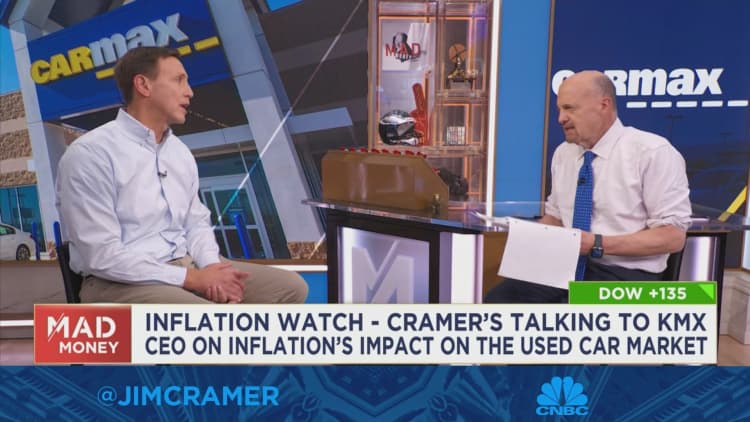- The third-quarter average monthly payment on a new vehicle was a record $736, up from $733 in the second quarter, according to Edmunds.
- The annual percentage rate on car loans also jumped in the third quarter, according to Edmunds.
- “What really is driving these prices is less inventory than before,” said Jessica Caldwell, Edmunds’ head of insights.
Prices keep creeping higher for shoppers in the market for a new or used vehicle.
Car prices and interest rates are higher, pushing up costs for drivers. Yet, pent-up demand has kept cars moving off lots, experts say, meaning dealers don’t have much reason to offer discounts.
“What really is driving these prices is less inventory than before,” said Jessica Caldwell, Edmunds’ head of insights. “Consumers are not getting necessarily the massive discounts they once were.”
The annual percentage rate on car loans jumped in the third quarter, according to Edmunds. The APR on loans for new vehicles rose to 7.4% and for used vehicles, to 11.2%, both levels last seen during the Great Recession.
More from Personal Finance:
53% of Gen Z see high cost of living as a barrier to success
Workers are asking for emergency savings accounts
These top colleges all promise no student loan debt
Rising rates contributed to higher costs. The third-quarter average monthly payment on a new vehicle was a record $736, up from $733 in the second quarter, according to Edmunds. For used cars, the average monthly payment slightly lowered to $567 from $569.
The auto market is still experiencing pent-up demand from drivers who had delayed buying new vehicles in 2020 but are now shopping around despite high costs.
“We’re getting to a point where people just can’t delay [purchases] any longer. They’re getting back into the market,” said Caldwell.
Fewer discounts, cars available
It’s still too soon to tell whether the ongoing United Auto Workers strike is affecting car prices, said Caldwell. Moreover, the strike might only affect a relatively small number of vehicles when compared to the auto market as a whole.
Car shoppers are instead seeing the effects of a low-inventory, high-demand market, leaving little to no room for discounts, experts say.
Historically, new model year vehicles would come into a dealer’s lot by the end of the summer to replace older inventory. At that point, dealers had motivation to offer discounts on leftover older models.

However, this year, “there are no leftovers,” said Tom McParland, regarding vehicles that serve the average consumer. McParland is a contributing writer for automotive website Jalopnik and operator of vehicle-buying service Automatch Consulting.
“There’s really no such thing as a leftover 2023 Sienna Hybrid because these cars are selling six to nine months before they even arrive at the dealership,” he added.
Car shoppers hardly saw similar end-of-summer sales last year either because of a chip shortage that reduced production levels, added Caldwell. The shortage of semiconductors during the Covid-19 pandemic led to a significant drop in produced vehicles, costing the auto industry billions in revenue.
For cars targeted to the average consumer, such as sedans, crossovers and hybrids, deals are hard to come by because of high demand and slow production, said McParland. On the other hand, there are leftover deals for luxury electric vehicles because those cars have been sitting around, he added.
It’s ‘a great time to look into the EV market’
However, there are some exceptions. Shoppers may see more inventory for different vehicles. EV availability was well above the industry average at the start of October as product availability and EV production rapidly increased, according to auto industry service provider Kelley Blue Book.
This leaves room for deals in a high-inventory market, said McParland.
“It is absolutely a great time to look into the EV market, both for new and pre-owned,” he said.
Additionally, recurring price cuts from Tesla this year might also soften prices in the EV market as a whole, added Caldwell.
The average price paid for an EV was $50,683 in September, down from $52,212 in August and down from more than $65,000 one year ago, according to Kelley Blue Book.
Pre-owned electric vehicles are more likely to go for a price under $25,000, which would qualify the car shopper for an additional federal tax credit of $4,000.
However, drivers shopping for a pre-owned vehicle should keep in mind that while EVs don’t have as many parts as gas-powered cars, it remains difficult to predict how long their rechargeable batteries will last.
EVs from five years ago or 2018 “weren’t as good,” said Caldwell, especially when looking at ranges and charging efficiency.
Shopping tips for a low-inventory car market
Overall, prices for cars at large are unlikely to drop significantly in the future. The technology that is being built into vehicles will further drive prices up “as we go towards electrification and autonomous technology,” added Caldwell.
“Those technologies are pricey.”
If you are currently in the market for a new or used car, do your research before heading to the dealership to make the best decision. Here are three tips:
- Get preapproval for an auto loan. Dealerships don’t always offer the most competitive financing. Shop for financing at your personal bank and other local financial institutions and credit unions online to see what type of loans and interest rates you can get, said Caldwell.
- Shop for both new and used car. Expand your research to increase the probability of finding good deals that work for your budget. If you weren’t a used car shopper before, looking into certified pre-owned vehicles can help bring you peace of mind, said Caldwell.
- Research trade-in values. If you’re trading in a vehicle, get quotes from different sources and dealers and try various appraisal features. “Definitely shop around and make sure you’re not leaving that money on the table,” she said.
Don’t miss these CNBC PRO stories:
